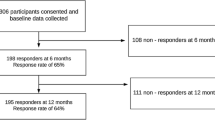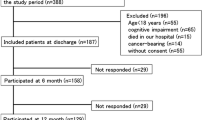Abstract
Purpose
As few studies have examined long-term health after penetrating injury, this population-based registry study sought to assess health outcomes up to 24 months post-injury.
Methods
Major trauma patients with penetrating trauma (2009–2017) were included from the Victorian State Trauma Registry (N = 1,067; 102 died, 208 were lost to follow-up). The EQ-5D-3L was used to measure health status at 6, 12 and 24-months. Mixed linear and logistic regressions were used to examine predictors of summary scores, and problems versus no problems on each health dimension.
Results
Average health status summary scores were 0.70 (sd = 0.26) at 6 and 12 months, and 0.72 (sd = 0.26) at 24 months post-injury. Prevalence of problems was consistent over time: mobility (24–26%), self-care (17–20%), usual activities (47–50%), pain/discomfort (44–49%), and anxiety/depression (54–56%). Lower health status and reporting problems was associated with middle-older age, female sex, unemployment; pre-injury disability, comorbid conditions; and assault and firearm injury versus cutting/piercing.
Conclusion
Problems with usual activities, pain/discomfort and anxiety or depression are common after penetrating major trauma. Risk factor screening in hospital could be used to identify people at risk of poor health outcomes, and to link people at risk with services in hospital or early post-discharge to improve their longer-term health outcomes.


Similar content being viewed by others
References
Fu, C. Y., Bajani, F., Tatebe, L., Butler, C., Starr, F., Dennis, A., Kaminsky, M., Messer, T., Schlanser, V., Kramer, K., Poulakidas, S., Cheng, C. T., Mis, J., & Bokhari, F. (2019). Right hospital, right patients: Penetrating injury patients treated at high-volume penetrating trauma centers have lower mortality. Journal of Trauma and Acute Care Surgery, 86(6), 961–966
Center for Disease Control and Prevention. (2020). Web-based Injury Statistics Query and Reporting System (WISQARS). https://wisqars-viz.cdc.gov:8006/analyze-compare/deaths/options
Rikken, Q. G. H., Chadid, A., Peters, J., Geeraedts, L. M. G., Giannakopoulos, G. F., & Tan, E. (2020). Epidemiology of penetrating injury in an urban versus rural level 1 trauma center in the Netherlands. Hong Kong Journal of Emergency Medicine. https://doi.org/10.1177/1024907920904190
Bäckman, P. B., Riddez, L., Adamsson, L., & Wahlgren, C. M. (2020). Epidemiology of firearm injuries in a Scandinavian trauma center. European Journal of Trauma and Emergency Surgery, 46(3), 641–647
Whittaker, G., Norton, J., Densley, J., & Bew, D. (2017). Epidemiology of penetrating injuries in the United Kingdom: A systematic review. International Journal of Surgery, 41, 65–69
Inkinen, J., Kirjasuo, K., Gunn, J., & Kuttila, K. (2015). Penetrating trauma; experience from Southwest Finland between 1997 and 2011, a retrospective descriptive study. European Journal of Trauma and Emergency Surgery, 41(4), 429–433
Johannesdottir, U., Jonsdottir, G. M., Johannesdottir, B. K., Heimisdottir, A. A., Eythorsson, E., Gudbjartsson, T., & Mogensen, B. (2019). Penetrating stab injuries in Iceland: A whole-nation study on incidence and outcome in patients hospitalized for penetrating stab injuries. Scandinavian Journal of Trauma, Resuscitation and Emergency Medicine. https://doi.org/10.1186/s13049-018-0582-2
O’Mullane, P. A., Mikocka-Walus, A. A., Gabbe, B. J., & Cameron, P. A. (2009). Incidence and outcomes of major trauma assaults: A population-based study in Victoria. Medical Journal of Australia, 190(3), 129–132
Sakran, J. V., Mehta, A., Fransman, R., Nathens, A. B., Joseph, B., Kent, A., Haut, E. R., & Efron, D. T. (2018). Nationwide trends in mortality following penetrating trauma: Are we up for the challenge? Journal of Trauma and Acute Care Surgery, 85(1), 160–166
Kalesan, B., Mobily, M. E., Keiser, O., Fagan, J. R. A., & Galea, S. (2016). Firearm legislation and firearm mortality in the USA: A cross-sectional, state-level study. Lancet, 387(10030), 1847–1855
Dijkink, S., Krijnen, P., Hage, A., Van der Wilden, G. M., Kasotakis, G., den Hartog, D., Salim, A., Goslings, J. C., Bloemers, F. W., Rhemrev, S. J., King, D. R., Velmahos, G. C., & Schipper, I. B. (2018). Differences in Characteristics and Outcome of Patients with Penetrating Injuries in the USA and the Netherlands: A Multi-institutional Comparison. World Journal of Surgery, 42(11), 3608–3615
Holbrook, T. L., Hoyt, D. B., Stein, M. B., & Sieber, W. J. (2001). Perceived threat to life predicts posttraumatic stress disorder after major trauma: Risk factors and functional outcome. Journal of Trauma, 51(2), 287–293
Ahl, R., Lindgren, R., Cao, Y., Riddez, L., & Mohseni, S. (2017). Risk factors for depression following traumatic injury: An epidemiological study from a scandinavian trauma center. Injury, 48(5), 1082–1087
Sluys, K., Haggmark, T., & Iselius, L. (2005). Outcome and quality of life 5 years after major trauma. Journal of Trauma, 59(1), 223–232
Cameron, P. A., Gabbe, B. J., McNeil, J. J., Finch, C. F., Smith, K. L., Cooper, D. J., Judson, R., & Kossmann, T. (2005). The trauma registry as a statewide quality improvement tool. Journal of Trauma and Acute Care Surgery, 59(6), 1469–1476
Victorian State Trauma Registry. (2017). Victorian state trauma system and registry annual report: 1 July 2015 to 30 June 2016. Melbourne: Victorian Government.
Australian Bureau of Statistics. (2001). Australian Standard Classification of Education (ASCED), Cat. No. 1272.0. In Australian Bureau of Statistics (Ed.). Canberra.
Australian Bureau of Statistics. (1997). Australian Standard Classification of Occupations (ASCO) (2nd Edition ed.).
Australian Bureau of Statistics. (2008). An introduction to Socio- Economic Index for Areas (SEIFA) (2039.0). In Australian Bureau of Statistics (Ed.). Canberra: Australian Bureau of Statistics.
Department of Health and Aged Care, & National Key Centre for Social Applications of Geographical Information Systems (GISCA). (2001). Measuring Remoteness: Accessibility/Remoteness Index of Australia (ARIA).
Nguyen, T. Q., Simpson, P. M., & Gabbe, B. J. (2017). The prevalence of pre-existing mental health, drug and alcohol conditions in major trauma patients. Australian Health Review, 41(3), 283–290
Charlson, M., Pompei, P., Ales, K., & MacKenzie, C. (1987). A new method of classifying prognostic comorbidity in longitudinal studies: Development and validation. Journal of Chronic Diseases, 40, 373–383
Association for the Advancement of Automotive Medicine (AAAM). (2008). The Abbreviated Injury Scale: 1990 Revision update 98 and AIS 2005 update 2008. Illinois, USA: AAAM.
Baker, S. P., O’Neill, B., Haddon, W., Jr., & Long, W. B. (1974). The injury severity score: A method for describing patients with multiple injuries and evaluating emergency care. Journal of Trauma, 14(3), 187–196
EuroQol, G. (1990). EuroQol–a new facility for the measurement of health-related quality of life. Health Policy, 16(3), 199–208
EuroQol Research Foundation. (2018). EQ-5D-3L User Guide, Version 6.0. https://euroqol.org/publications/user-guides/
Dipnall, J. F. (2020). A command to calculate index values for the EQ-5D quality of life instrument for Australian data. Melbourne: School of Public Health and Preventive Medicine, Monash University.
Hayden, J. A., Cote, P., & Bombardier, C. (2006). Evaluation of the quality of prognosis studies in systematic reviews. Annals of Internal Medicine, 144(6), 427–437
Van Buuren, S. (2007). Multiple imputation of discrete and continuous data by fully conditional specification. Statistical Methods in Medical Research, 16(3), 219–242
Rubin, D. B. (1987). Multiple imputation for nonresponse in surveys. (Vol. 81)New York: Wiley.
Clemens, S., Begum, N., Harper, C., Whitty, J. A., & Scuffham, P. A. (2014). A comparison of EQ-5D-3L population norms in Queensland, Australia, estimated using utility value sets from Australia, the UK and USA. Quality of Life Research, 23(8), 2375–2381
EuroQol Research Foundation. EQ-5D-3L User Guide, 2018. Available from: https://euroqol.org/publications/userguides.
Giummarra, M. J., Lau, G., Grant, G., & Gabbe, B. J. (2020). A systematic review of the association between fault or blame-related attributions and procedures after transport injury and health and work-related outcomes. Accident Analysis & Prevention, 135, 105333
Gabbe, B. J., Simpson, P. M., Cameron, P. A., Ponsford, J., Lyons, R. A., Collie, A., Fitzgerald, M., Judson, R., Teague, W. J., Braaf, S., Nunn, A., Ameratunga, S., & Harrison, J. E. (2017). Long-term health status and trajectories of seriously injured patients: A population-based longitudinal study. PLOS Medicine, 14(7), e1002322
Leach, L. S., Christensen, H., Windsor, T. D., Butterworth, P., & Mackinnon, A. J. (2008). Gender differences in depression and anxiety across the adult lifespan: the role of psychosocial mediators. Social Psychiatry and Psychiatric Epidemiology, 43(12), 983–998
Ziersch, A. M., Baum, F. E., MacDougall, C., & Putland, C. (2005). Neighbourhood life and social capital: the implications for health. Social Science & Medicine, 60(1), 71–86
Lubetkin, E. I., Jia, H. M., Franks, P., & Gold, M. R. (2005). Relationship among sociodemographic factors clinical conditions, and health-related quality of life: Examining the EQ-5D in the US general population. Quality of Life Research, 14(10), 2187–2196
Russo, J., Katon, W., & Zatzick, D. (2013). The development of a population-based automated screening procedure for PTSD in acutely injured hospitalized trauma survivors. General Hospital Psychiatry, 35(5), 485–491
Brooke, B. S., Efron, D. T., Chang, D. C., Haut, E. R., & Cornwell, E. E. (2006). Patterns and outcomes among penetrating trauma recidivists: It only gets worse. Journal of Trauma, 61(1), 16–19
Acknowledgements
This work was supported by staff within Monash University Helix and the Monash eResearch Centre. The Secure eResearch Platform is underpinned by world-leading infrastructure to ensure ongoing security and privacy of any data is maintained. This project was supported by funding from the Australian Research Council (MJG: DE170100726; BB: DE180100825; BJG: FT170100048). The Victorian State Trauma Registry (VSTR) is funded by the Department of Health, State Government of Victoria and the Transport Accident Commission.
Author information
Authors and Affiliations
Contributions
All authors contributed to the study conception and design. Material preparation, data preparation and analysis were performed by MJG, JD and GG. The first draft of the manuscript was written by MJG and all authors commented on previous versions of the manuscript. All authors read and approved the final manuscript.
Corresponding author
Additional information
Publisher's Note
Springer Nature remains neutral with regard to jurisdictional claims in published maps and institutional affiliations.
Supplementary Information
Below is the link to the electronic supplementary material.
Rights and permissions
About this article
Cite this article
Giummarra, M., Dipnall, J.F., Gibson, G. et al. Health status after penetrating major trauma in Victoria, Australia: a registry-based cohort study. Qual Life Res 30, 3511–3521 (2021). https://doi.org/10.1007/s11136-021-02876-4
Accepted:
Published:
Issue Date:
DOI: https://doi.org/10.1007/s11136-021-02876-4




